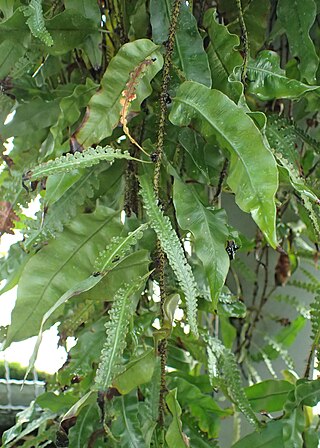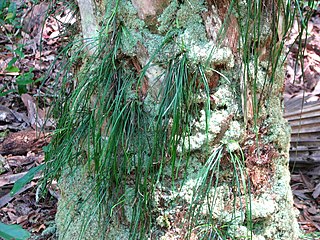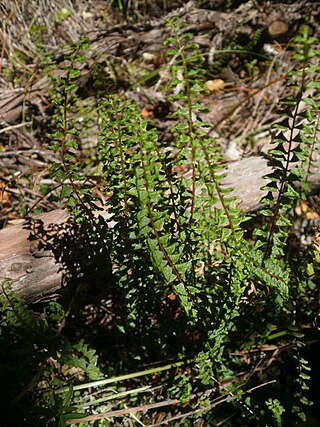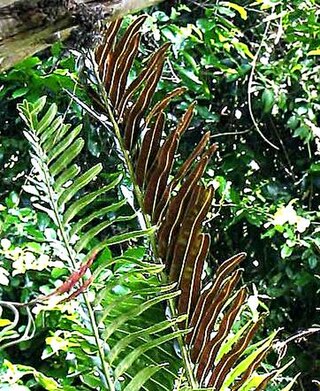
Oleandra is a genus of ferns. In the Pteridophyte Phylogeny Group classification of 2016, it is the only genus in the family Oleandraceae, which is placed in suborder Polypodiineae, order Polypodiales. Alternatively, the family may be placed in a very broadly defined family Polypodiaceae sensu lato as the subfamily Oleandroideae.

The Cyatheaceae are a family of ferns, the scaly tree ferns, one of eight families in the order Cyatheales in the Pteridophyte Phylogeny Group classification of 2016. Alternatively, the family may defined much more broadly as the only family in the Cyatheales, with the PPG I family treated as the subfamily Cyatheoideae. The narrower circumscription is used in this article.

Pteridaceae is a family of ferns in the order Polypodiales, including some 1150 known species in ca 45 genera, divided over five subfamilies. The family includes four groups of genera that are sometimes recognized as separate families: the adiantoid, cheilanthoid, pteridoid, and hemionitidoid ferns. Relationships among these groups remain unclear, and although some recent genetic analyses of the Pteridales suggest that neither the family Pteridaceae nor the major groups within it are all monophyletic, as yet these analyses are insufficiently comprehensive and robust to provide good support for a revision of the order at the family level.

The Athyriaceae are a family of terrestrial ferns in the order Polypodiales. In the Pteridophyte Phylogeny Group classification of 2016 (PPG I), the family is placed in the suborder Aspleniineae, and includes two genera. Alternatively, it may be treated as the subfamily Athyrioideae of a very broadly defined family Aspleniaceae. The family has with a cosmopolitan distribution.

Ceratopteris is the only genus among homosporous ferns that is exclusively aquatic. It is pan-tropical and classified in the Parkerioideae subfamily of the family Pteridaceae.

Vittaria, the shoestring ferns, is a genus of ferns in the Vittarioideae subfamily of the family Pteridaceae. It had previously been placed in the family Vittariaceae, but that family is no longer recognized.

Lindsaeaceae is a pantropical family of ferns in the order Polypodiales. It contains six or seven genera with about 220 known species, some of which also extend into the more temperate regions of eastern Asia, New Zealand, and South America.

Saccolomataceae is a family of ferns in the order Polypodiales with about 19 species. It has been formerly treated as part of the Dennstaedtiaceae, however it has been classified as its own family according to Smith et al. (2006) The genus Saccoloma has been classified to include Orthiopteris, but the phylogeny of the group not yet fully understood. The family includes a dozen known species.

Cryptogramma is a genus of ferns known commonly as rockbrakes or parsley ferns. They are one of the three genera in the Cryptogrammoideae subfamily of the Pteridaceae. Cryptogramma ferns can be found in temperate regions on several continents worldwide. These ferns have two kinds of leaves which often look so different that at first glance they appear to belong to different plants. The fertile leaves have long, narrow, bumpy segments with undersides covered thickly in sporangia. The edges of the segments may curl back to cover the sporangia, forming a false indusium. The sterile leaves have thinner, wider segments which may be rounded and resemble the leaves of parsley. These ferns grow in rocky areas, often in crevices and cracks.

Antrophyum is a genus of ferns in the family Pteridaceae. They are commonly known as lineleaf ferns.

The forked ferns are the family Gleicheniaceae, which includes six genera and about 160 known species. The formerly independent families Dicranopteridaceae and Stromatopteridaceae are generally included in the Gleicheniaceae, whereas the Dipteridaceae and Matoniaceae, although closely related, are considered separate families by most authors.

Marattia is a small genus of primitive, large, fleshy eusporangiate ferns. It is the type genus of the family Marattiaceae, order Marattiales and class Marattiopsida. Formerly considered to be a much larger genus, genetic analysis has shown that Marattia in the broad sense was paraphyletic, and subsequently the genera Ptisana and Eupodium were split off. Except for one species in Hawaii, the genus is neotropical.

Bommeria is a genus of small pteridaceous rock ferns, native to the New World. Genetic analysis has shown it to be a stem offshoot clade of all the cheilanthoid ferns, except for Doryopteris, which is an even more basal ("primitive") stem offshoot. for years, it was assumed that this genus was closely allied with Hemionitis, but genetic analysis has shown that genus to be a more advanced genus evolutionarily. The same set of analysis has shown many presumed genera within this family to be paraphyletic, but the small genus Bommeria appears to be monophyletic, or a natural genus.

Jamesonia is a genus of ferns in the subfamily Pteridoideae of the family Pteridaceae. It now includes the formerly separate genus Eriosorus.

Acrostichum is a fern genus in the Parkerioideae subfamily of the Pteridaceae. It was one of the original pteridophyte genera delineated by Linnaeus. It was originally drawn very broadly, including all ferns that had sori apparently "acrostichoid", or distributed in a uniform mass across the back of the frond, rather than organized in discrete sori. This led Linnaeus to include such species as Asplenium platyneuron in the genus, because the specimen he received had sori so crowded that it appeared acrostichoid.

Calochlaena is a genus of ferns within the family Dicksoniaceae. Although these ground ferns resemble bracken, they are only distantly related. Five species are known from Melanesia, Polynesia and eastern Australia. Calochlaena dubia, is a common fern of the east coast of Australia. The name is derived from the Ancient Greek kalos "beautiful" and chlaina "cloak", and refers to the soft hairs on the species.

Vittarioideae is a subfamily of the fern family Pteridaceae, in the order Polypodiales. The subfamily includes the previous families Adiantaceae and Vittariaceae.
Haplopteris is a genus of vittarioid ferns, a member of subfamily Vittarioideae and family Pteridaceae.
Polytaenium is a genus of ferns in the subfamily Vittarioideae of the family Pteridaceae. Species are native to Mexico and Southern America.
Radiovittaria is a genus of ferns in the subfamily Vittarioideae of the family Pteridaceae. Species are native to southeast Mexico and northern Southern America.
















